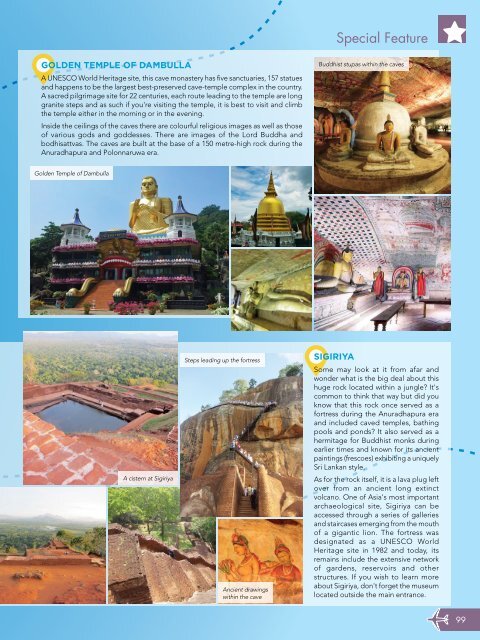CONVERGENCE SEPT-OCT 2017
Malaysia's Airports Magazine
Malaysia's Airports Magazine
Create successful ePaper yourself
Turn your PDF publications into a flip-book with our unique Google optimized e-Paper software.
Special Feature<br />
Golden Temple of Dambulla<br />
A UNESCO World Heritage site, this cave monastery has five sanctuaries, 157 statues<br />
and happens to be the largest best-preserved cave-temple complex in the country.<br />
A sacred pilgrimage site for 22 centuries, each route leading to the temple are long<br />
granite steps and as such if you're visiting the temple, it is best to visit and climb<br />
the temple either in the morning or in the evening.<br />
Inside the ceilings of the caves there are colourful religious images as well as those<br />
of various gods and goddesses. There are images of the Lord Buddha and<br />
bodhisattvas. The caves are built at the base of a 150 metre-high rock during the<br />
Anuradhapura and Polonnaruwa era.<br />
Buddhist stupas within the caves<br />
Golden Temple of Dambulla<br />
A cistern at Sigiriya<br />
Steps leading up the fortress<br />
Ancient drawings<br />
within the cave<br />
Sigiriya<br />
Some may look at it from afar and<br />
wonder what is the big deal about this<br />
huge rock located within a jungle? It's<br />
common to think that way but did you<br />
know that this rock once served as a<br />
fortress during the Anuradhapura era<br />
and included caved temples, bathing<br />
pools and ponds? It also served as a<br />
hermitage for Buddhist monks during<br />
earlier times and known for its ancient<br />
paintings (frescoes) exhibiting a uniquely<br />
Sri Lankan style.<br />
As for the rock itself, it is a lava plug left<br />
over from an ancient long extinct<br />
volcano. One of Asia's most important<br />
archaeological site, Sigiriya can be<br />
accessed through a series of galleries<br />
and staircases emerging from the mouth<br />
of a gigantic lion. The fortress was<br />
designated as a UNESCO World<br />
Heritage site in 1982 and today, its<br />
remains include the extensive network<br />
of gardens, reservoirs and other<br />
structures. If you wish to learn more<br />
about Sigiriya, don't forget the museum<br />
located outside the main entrance.<br />
99

















